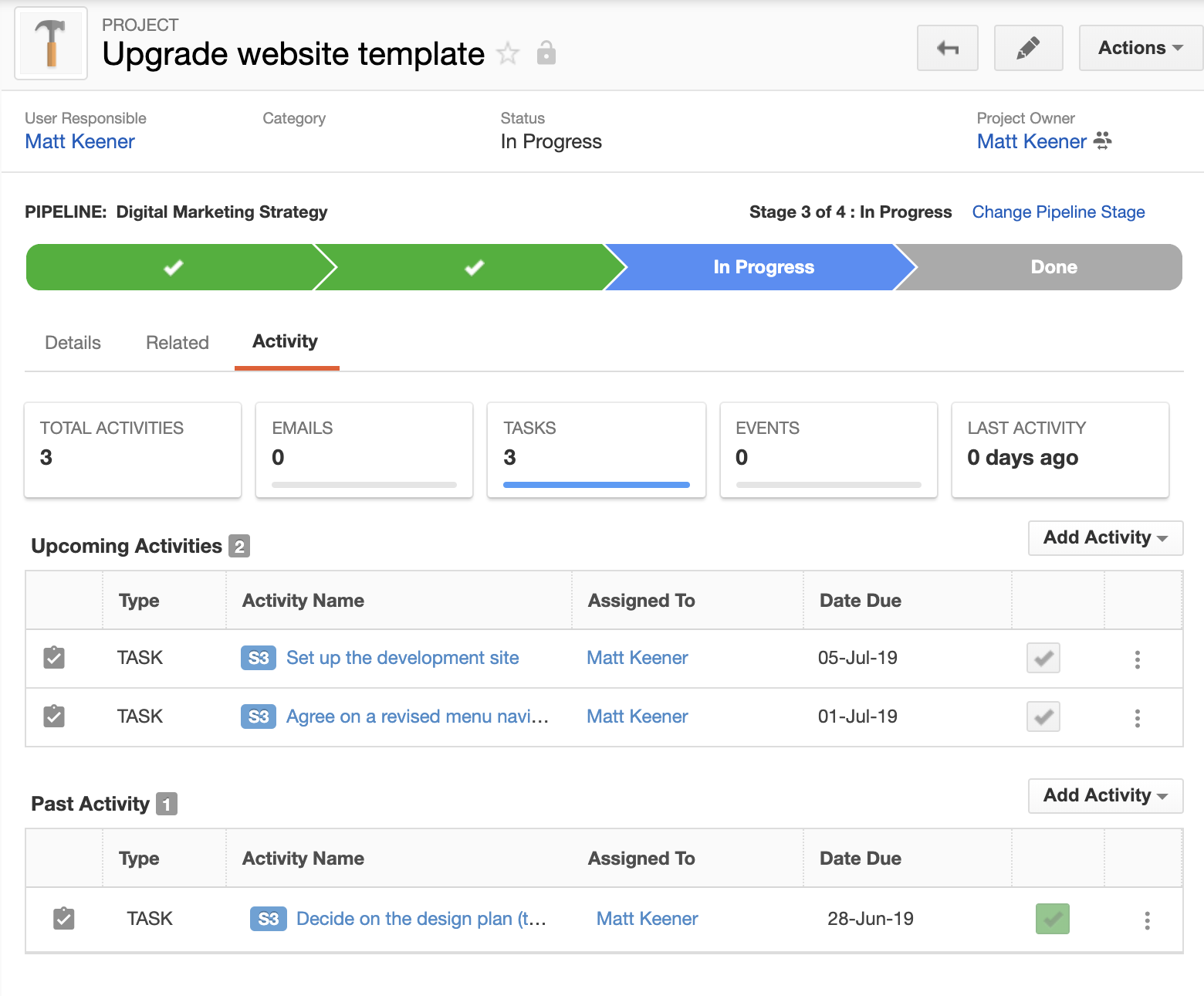Marketing
Step-by-step guide to launching digital marketing (part 3)
You’ve broken your digital marketing projects into small, manageable tasks. Your team has created realistic timelines and budgets for achieving your goals. Everyone is excited to begin work.
Now what?
In this article, the last in the launching digital marketing series, we’ll explore how to convert a solid plan into a successful digital marketing program.
Host a kickoff meeting
For an avid sports fan like me, summer is an awesome time of year. Baseball season is in full swing. Golf is, too. Hockey and basketball seasons have just recently come to an exciting conclusion. And, football season is just around the corner.
Now, you might be asking yourself what my love of sports has to do with your digital marketing. Allow me to explain.
Sporting events can teach us something useful about project management, especially when it comes to kickoffs. Take a football game, for example. Before play can commence, captains from both teams meet at the 50 yard line to shake hands, exchange pleasantries, discuss venue-specific ground rules with officials, and perform the coin toss.
Why do football games begin this way? Wouldn’t it be better to take care of such formalities in the privacy of the clubhouse, thereby saving everyone an extra ten minutes? In truth, the pregame meeting serves several key roles. First, the meeting’s public and ceremonial nature tells everyone in the building — from offensive line coach to hot dog vendor — that something momentous is about to happen (in this case, the start of a game). In a more practical sense, the pregame meeting also provides vital information to players, coaches, and referees, such as which team will kick off and which team will receive the ball.
Bringing all of this back to your digital marketing, the importance of a project kickoff meeting cannot be understated. A well-run kickoff signifies to all contributors that the project is ready to start and is worthy of everyone’s undivided attention. The meeting should iron out any remaining questions and reconfirm your assumptions pertaining to goals, dates, budgets, and tasks. A successful kickoff meeting brings together key stakeholders, clears up any confusion, and gets everyone buzzing about the project.
 Implement a daily check-in
Implement a daily check-in
Even the best kickoff meeting provides little value without the proper follow-through. After all, most digital marketing projects aren’t begun and completed in a day. Many, if not all, require weeks or months of continuous work, collaboration, and refinement.
Brief daily check-in meetings are an effective way to keep projects on track without creating unnecessary red tape. When I say “brief,” I mean 15 to 20 minutes max. The team leader should use this time to cover three main issues with each team member:
- Work that has been recently completed
- Work that is up next
- Any issues that are preventing work from getting done
Having managed many digital marketing teams over the past decade, I’ve seen daily check-ins occur through a variety of formats, including:
- Chat-only meetings: No spoken words are exchanged. Instead, instant messaging services, such as Skype or Slack, are used to share updates and provide feedback. This type of meeting is particularly helpful when managing teams in different global time zones or for overcoming language barriers. Team members can post updates as they occur rather than trying to coordinate a fixed time for everyone to connect. Chat-only meetings can be very time efficient, except when you’re dealing with complex technical issues that are better resolved through verbal communication and screen sharing.
- Voice and/or video conferences: Daily check-ins can also be hosted as voice or video conferences using online platforms, such as Zoom or GoToMeeting. This type of meeting fosters a greater sense of alignment, especially among remote teams who rarely experience in-person interactions with their colleagues. Unfortunately, in my experience, online conferences tend to run long and consume additional time that could otherwise be used for completing work. It helps to let all participants know that you have a hard stop at a certain time, and unless there is an urgent issue that requires more time and attention, you’ll be wrapping the meeting.
- In-person conferences: Unless your entire team is based in a corporate office, in-person check-ins are increasingly rare. With the advent of online freelancing and virtual teams, even small and midsize companies are embracing a distributed workforce structure. If you’re able to and prefer to hold in-person meetings, then figure out the best place and time and set up a recurring meeting. Having a standing agenda or a meeting format can also help to keep in-person check-ins brief and productive.
- Hybrid: Perhaps part of your team is in a corporate office and everyone else works from home. Or, perhaps most check-ins can be done via chat, but you still like to get everyone together once a week. Taking a hybrid approach to daily check-ins can provide a healthy mix of flexibility and efficiency.
Measure progress with data
Companies large and small are leveraging data to accelerate growth and achieve more goals. If you’re using a data-driven project management system, such as Insightly, you can convert your business data into meaningful insights to ensure digital marketing initiatives stay on track.
Since you’re just getting started with digital marketing, your project-level data may not be very insightful yet. As we discussed in my previous article, however, a project is nothing more than a collection of smaller tasks and milestones that share a common goal. A well-structured project management system should therefore make it easy to monitor progress by presenting task and milestone activity data in a clear and concise manner. See below an example of a project setup and tracking in Insightly CRM.

As tasks and milestones are completed and projects advance toward completion, your project-level data becomes more meaningful — especially if you’re using a tool that offers interactive business intelligence modeling.
Note: No project plan is perfect. As a project progresses, you’re bound to encounter unforeseen tasks, milestones, and changes that cause delays and create frustration for the team. Although some changes are to be expected, a good project leader resists major extensions to the project’s original scope. Anything beyond the original scope should be added to the backlog for future sequencing. This will help to keep existing priorities on track and avoid watering down your in-progress project data.
Document your lessons learned
Closing out a successfully completed project is another great opportunity for the team to connect and grow.
Having tracked all activity and documentation within an online project management system, you have the luxury to compare actual results against your original digital marketing plan. Challenge your team to identify data-driven answers to important questions, such as:
- How accurate was our original timeline and budget?
- What could have made this project even more successful?
- Where did you deviate from the plan?
- What was the main cause of deviation (either positive or negative)?
- Was there a specific task or milestone that caused a delay?
- Did we get sidetracked by a different project?
- Do we need to add new team members in order to build additional capacity?
- What expenses did we incur that were not factored into the plan?
- Did we learn any new facts or acquire new skills?
- What, if any, recurring tasks should be created and assigned moving forward? For example, website maintenance, site backups, etc.
- Do we need to create work instructions for certain processes that have been established?
- Should we recycle this project as a template in order to accelerate similar projects in the future?
Be sure to document all of your lessons learned within your project file. Documentation is not useful unless it’s easily accessible for future reference. Linking your documentation to your project keeps everything nice and tidy.

Celebrate your team’s success
As projects move across the finish line, it’s also time to celebrate your victories. Your team worked hard to achieve their goals and they appreciate your recognition of their efforts. So, when that shiny new website goes live, consider making a big deal by:
- Sharing the news on an internal Slack channel
- Sending a company-wide email
- Giving a shout-out in an upcoming company meeting
- Publishing a blog post that marks the accomplishment
- Boosting the news on social media with an ad or two
- Doing something fun as a team
Showing your appreciation makes your team all the more willing to exceed your future expectations. Plus, it’s just the right thing to do!
Digital marketing success
With the right strategy, team, technology, and resources, almost any company can leverage digital marketing to increase pipeline, accelerate growth, and enhance its bottom line. My hope is that this multi-part series has inspired you take action and make digital marketing a strategic asset for your business.
Here’s to your future success!
Skipped the first two articles in the series or want to revisit the steps to digital marketing success? Here are the articles:
